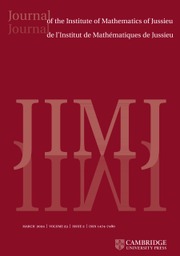Article contents
TWO-DIMENSIONAL MINIMAL GRAPHS OVER UNBOUNDED DOMAINS
Published online by Cambridge University Press: 14 October 2002
Abstract
In this paper we will study solution pairs $(u,D)$ of the minimal surface equation defined over an unbounded domain $D$in $R^2$, with $u=0$ on $\partial D$. It is well known that there are severe limitations on the geometry of $D$; forexample $D$ cannot be contained in any proper wedge (angle less than $\pi$). Under the assumption of sublinear growthin a suitably strong sense, we show that if $u$ has order of growth $\alpha$ in the sense of complex variables, thenthe ‘asymptototic angle’ of $D$ must be at least $\pi/\alpha$. In particular, there are at most two such solution pairsdefined over disjoint domains. If $\alpha<1$ then $u$ cannot change sign and there is no other disjoint solution pair.This result is sharp as can be seen by a suitable piece of Enneper’s surface which has order$\alpha=\tfrac{2}{3}$ and asymptotic angle $\tfrac{3}{2}\pi$.
AMS 2000 Mathematics subject classification: Primary 35J60; 53A10
Information
- Type
- Research Article
- Information
- Journal of the Institute of Mathematics of Jussieu , Volume 1 , Issue 4 , October 2002 , pp. 631 - 640
- Copyright
- 2002 Cambridge University Press
- 6
- Cited by

